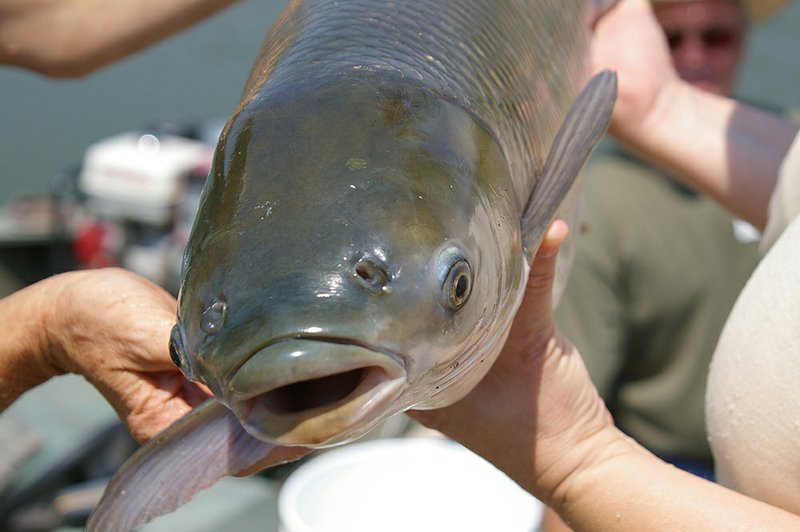To catch a grass carp, toss a salad. Throw in some cherry tomatoes, some lettuce, celery, pea pods, a bit of watercress, some duckweed, coontail, pondweed and muskgrass. OK, so it’s not your regular salad, and chances are you never figured on using vegetables for bait. Don’t worry; grass carp will like it, just the same.
These giant Asian minnows, also known as white amurs (Ctenopharyngodon idella), are vegetarians, you see. They shy away from “normal” baits like kids eyeing a plate of liver and onions. Cast some veggies their way, though, and they’ll rush in like a kitty to a can opener.
And why, you may ask, would you want to hook a grass carp in the first place? Because, my friend, these underrated ruffians often weigh 40 pounds or more. Specimens topping 110 are known, and grass carp of any size immediately go airborne when hooked. Fish farmers wear catcher’s masks and pads when seining grass carp because they’re notorious net-jumpers. Battling one on rod and reel is like tussling with a tail-hooked tarpon. In fact, long sleek grass carp resemble tarpon, with big silvery scales and an upturned mouth. They’re not at all like common carp, which have whiskered, vacuum-cleaner snouts.
Grass carp are mighty good eating, too. A platter of deep-fried strips won’t last long at a backyard fish fry. And chances are, there are lakes and ponds near your home with plentiful grass carp that could use a little thinning, as grass carp are commonly stocked by the Arkansas Game and Fish Commission.
Most folks won’t complain if you thin grass carp, either. In fact, some will say you’re doing the world a favor by catching all you can and ridding our waters of this alien invader. The name “carp” still sends shivers down spines of the unknowing.
Grass carp were introduced into the U.S. in 1963, when the Bureau of Sport Fisheries brought 70 fish from Malaysia to the Fish Farming Experiment Station at Stuttgart, Arkansas. Amurs are native to larger east-Asian rivers with Pacific drainages, including their namesake, the Amur River on the Chinese-Siberian border. But introductions have expanded their range to India, Europe, New Zealand and, according to some researchers, at least 40 U.S. states.
The experimental imports did what they were supposed to do — eat excessive aquatic vegetation — and by the early 1970s, the Arkansas Game and Fish Commission began using grass carp to control weeds in public waters. The amur’s mouth is toothless, but in the throat are two rows of large, comblike teeth that grind the salad the fish eats. One carp can eat two to three times its weight daily and may gain 5 to 10 pounds a year.
Early grass-carp introductions were controversial from the get-go. Some claimed they were needed to control vegetation, providing a natural alternative to costly chemical and mechanical controls. Grass-carp opponents saw nothing “natural” about importing an Oriental fish and releasing it to become a 50-pound intruder gobbling up bass habitat.
The controversy continues. Some states allow stocking sterile fish produced in hatcheries; a few outlaw grass carp completely. Amurs offer a trouble-free, ongoing method of weed control when stocked at the conservative rates recommended by fisheries biologists. But once weeds are in check, biologists recommend reducing by at least 50 percent the number of grass carp in a pond or lake. That’s where fishermen come in.
Ken Perry, a fisheries program coordinator for the Missouri Department of Conservation, outlined a simple method for catching grass carp in an agency newsletter. First, he scatters 2 or 3 cups of
fermented corn in shallow areas of the lake he’s going to fish. “Fifty pounds of cracked corn cost next to nothing at a feed store,” he said. “Fill a quart milk jug with cracked corn, and add water a few days before fishing.” The soured corn attracts carp to the fishing area.
Next, Perry employs his secret weapon — cherry tomatoes. Canned corn, earthworms and other baits work, too, but these also attract catfish and bream. With tomatoes, Perry said, you can target grass carp specifically.
Perry’s fishing rig consists of a long limber rod-and-reel combo spooled with light monofilament line to which is tied a single, heavy-wire No. 1 hook without a sinker. The reel is placed in free-spool so line plays out freely when a fish takes the bait. If there’s no bite in 30 minutes, Perry changes spots.
“Many lakes that need grass carp taken out are privately owned,” Perry said. “Often the owners will be delighted to get rid of the fish, but be sure to get permission first.”
In waters where most weeds have been eliminated, amurs are especially easy to catch. They often feed at the surface and quickly rise to hooked bits of aquatic vegetation, vegetables, even french fries floating in the water. Warm months offer the best fishing; feeding activity slackens when water temperature falls below 57 degrees Fahrenheit.
In his book Fishing for Buffalo, Rob Buffler says floating doughballs also take hungry grass carp. His recipe calls for mixing equal parts peanut butter, Rice Krispies and crushed cornflakes.
“Place a grape-sized glob of this mixture and a green party marshmallow on a 2-inch square of white, sheer pantyhose,” Buffler said. “Stretch it tightly over the doughball, and tie up the ends with green thread to make a ball. Roll the ball in green food coloring.”
Thread a baitholder hook through the pantyhose material, and cast the ball into waters where grass carp feed. With luck, a giant amur will rise and take the bait.
Grass carp may never become standard fare in the waters of Arkansas and other states, but they’re widely available and offer great fun for anglers who like tackling “those other fish.” If you’re not embarrassed by the thought of fishing with a tomato or french fries for bait, give amurs a try. Somewhere out there, a 100-pounder is lurking.
